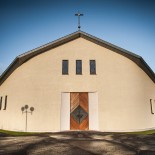The St. Brigid’s Cross
St. Brigid was born in the fifth century and died in the sixth century in the year 524. She founded a monastery at Kildare, and even what remains of the site today bears eloquent witness to the significance of the foundation. Naturally, it is not only a pilgrimage site but also a tourist destination, and as the visitor approaches up the hill the present stone structure of the Church of Ireland marks where the ancient Oak Church (Cill Dara) would have stood, and behind it a tall, well-preserved round tower dominates the scene. The land slopes away on one side to where the monastery of the men was located, and on the other side to the monastery of the women.
The scale of the complex makes it easy to identify with the tradition that St. Brigid won a generous grant of land from the local king against his will: it is said he offered her as much land as her cloak would cover, upon which she spread out her cloak and it miraculously extended in all directions to claim the magnificent site on which she based her monastery. Another tradition tells that she gave away her father’s sword to a poor beggarman who asked for alms. The sword was encrusted with jewels, and had great value. But as well as providing wealth for the poor man, it also came to symbolise Brigid’s opposition to the violence which the sword represented.
The St. Brigid’s Cross embodies another of the foundational stories of this national saint. The story goes that Brigid visited a local pagan king on his deathbed. She told him about Jesus Christ, and as she talked she lifted rushes from the floor covering around his bed, and wove them into the shape of a cross. She explained to the king that Jesus had died on the cross for our salvation. The king was converted and was baptised before he died. That moment of conversion lives on in the annual custom of making the St. Brigid’s Cross from rushes or straw. The crosses are made on the eve of St. Brigid’s feast, which is on the First of February, the first day of Spring. Prayers are said, and often the crosses are blessed at the Mass of the Feast. In many parishes there is a conscious effort to hand on the tradition, and adults teach the young people how to make the rush crosses, at school or at a parish gathering.
In the Irish language version of the Marriage Rite of the Catholic Church in Ireland there is a beautiful blessing which can be used as the final blessing of the wedding Mass. The words in Irish go back for centuries. When a couple were getting married, their parents would take a St. Brigid’s cross which had been hanging in their home, and present it to the young couple to hang in their home. It became a symbol of handing on the traditions of the family and the traditions of the Faith. The tradition of the St. Brigid’s Cross is alive and well in the parish of Greenlough, and couples getting married very often incorporate this blessing into their wedding ceremony. A parent or parents usually carry up the cross in procession and hand it to the bride and groom to hold between their joined hands during the final blessing. Afterwards they bring it to their own home.






